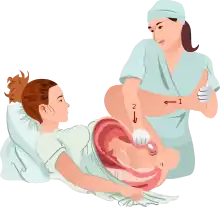McRoberts maneuver

The McRoberts maneuver is an obstetrical maneuver used to assist in childbirth. It is named after William A. McRoberts, Jr.[1] It is employed in case of shoulder dystocia during childbirth and involves hyperflexing the mother's legs tightly to her abdomen. It is effective due to the increased mobility at the sacroiliac joint during pregnancy, allowing rotation of the pelvis and facilitating the release of the fetal shoulder.[2] If this maneuver does not succeed, an assistant applies pressure on the lower abdomen (suprapubic pressure). Current guidelines strongly recommend against pulling on the infants head, as this could lead to brachial plexus injury. Instead, support while keeping the neck straight is indicated. The technique is effective in about 42% of cases. [3] Note that suprapubic pressure and McRobert's maneuver together will resolve 90% of cases.
See also
References
- ↑ Gonik, B.; Stringer, C. A.; Held, B. (1983). "An alternate maneuver for management of shoulder dystocia". American Journal of Obstetrics and Gynecology. 145 (7): 882–884. doi:10.1016/0002-9378(83)90694-4. PMID 6837666.
- ↑ Gherman, R. B.; Tramont, J.; Muffley, P.; Goodwin, T. M. (2000). "Analysis of McRoberts' maneuver by x-ray pelvimetry". Obstetrics and Gynecology. 95 (1): 43–47. doi:10.1016/s0029-7844(99)00445-7. PMID 10636500. S2CID 2430403.
- ↑ Kish, Karen; Joseph V. Collea (2003). "Malpresentation & Cord Prolaps (Chapter 21)". In Alan H. DeCherney (ed.). Current Obstetric & Gynecologic Diagnosis & Treatment. Lauren Nathan (Ninth ed.). Lange/McGraw-Hill. pp. 381–382. ISBN 0-07-118207-1.